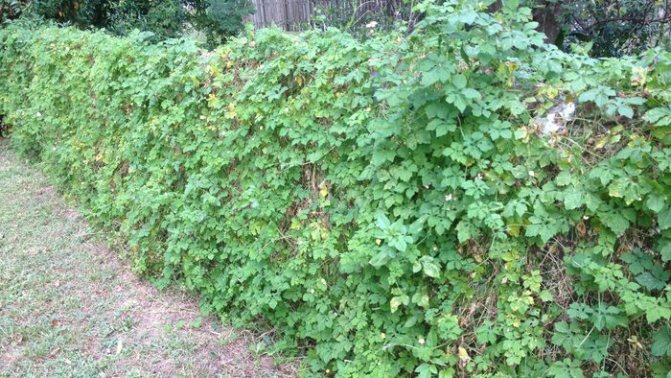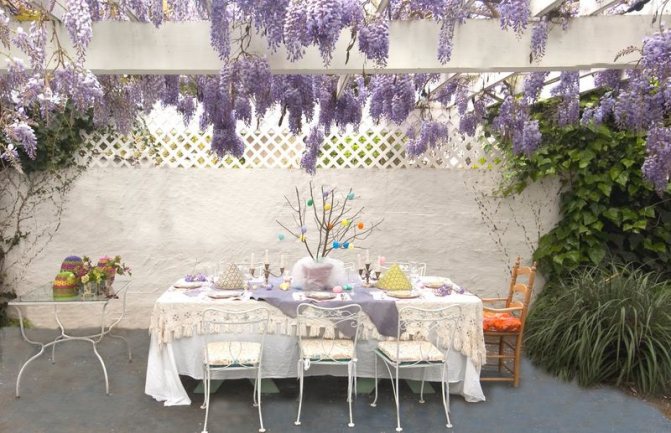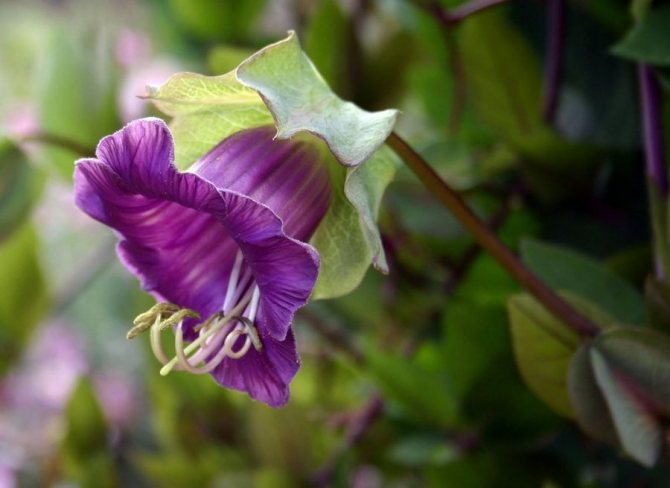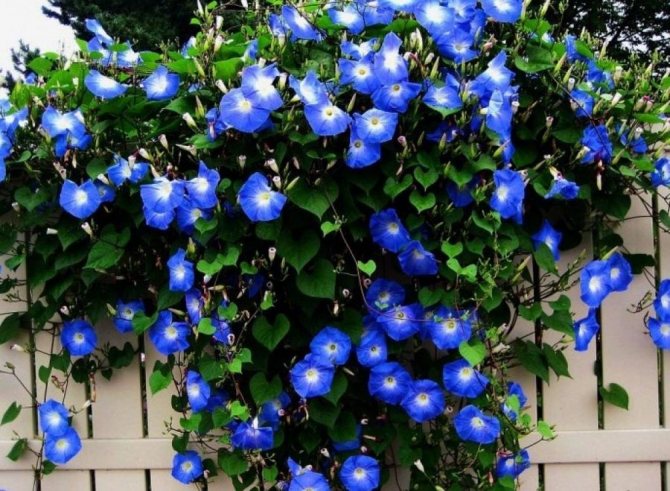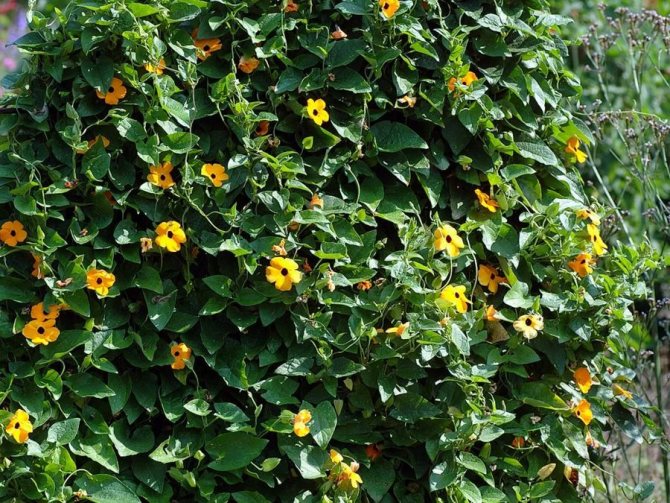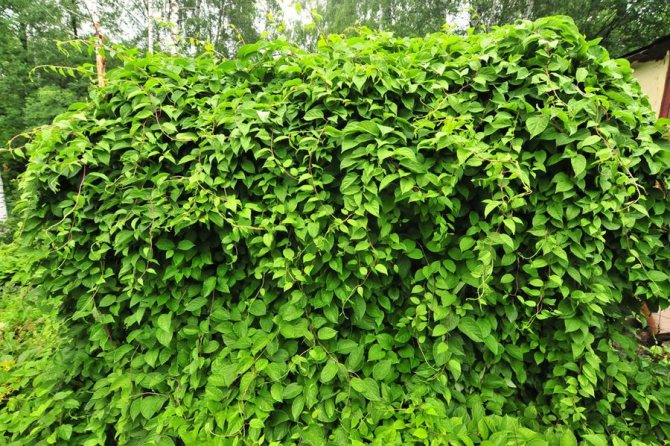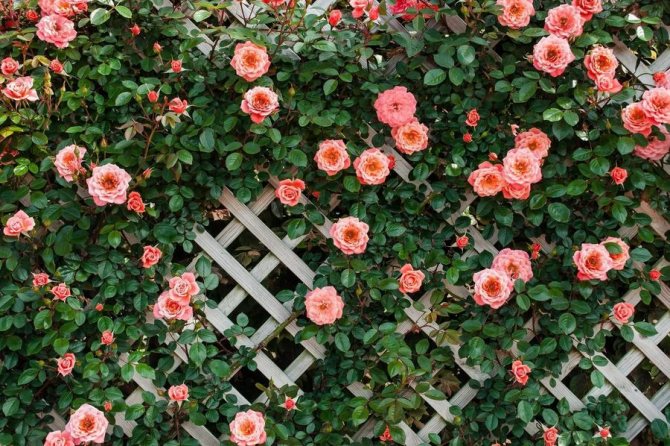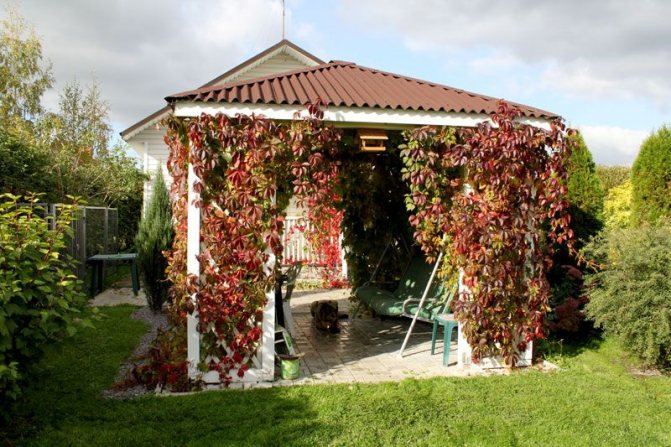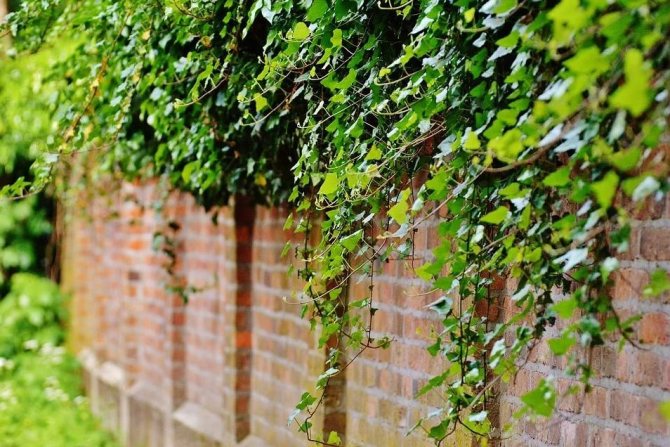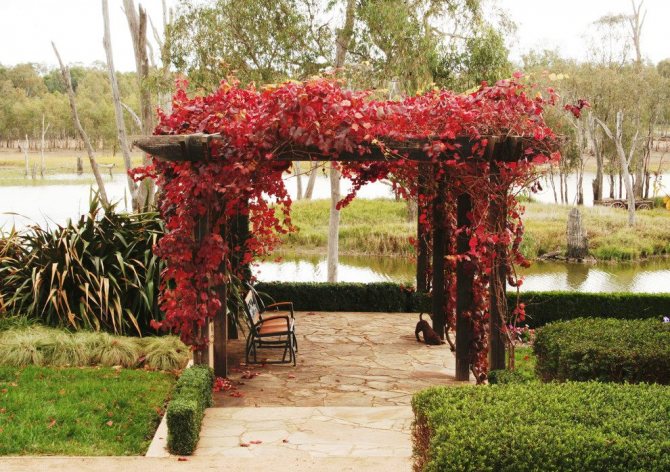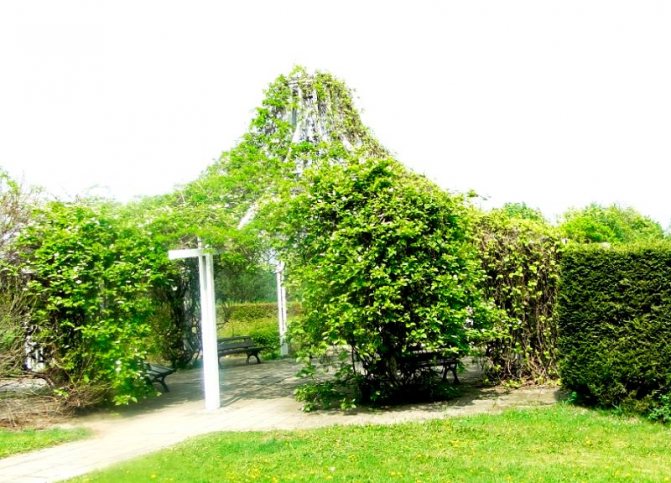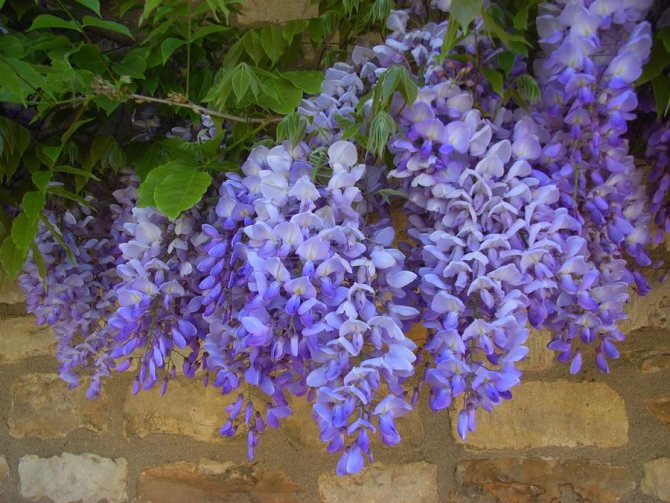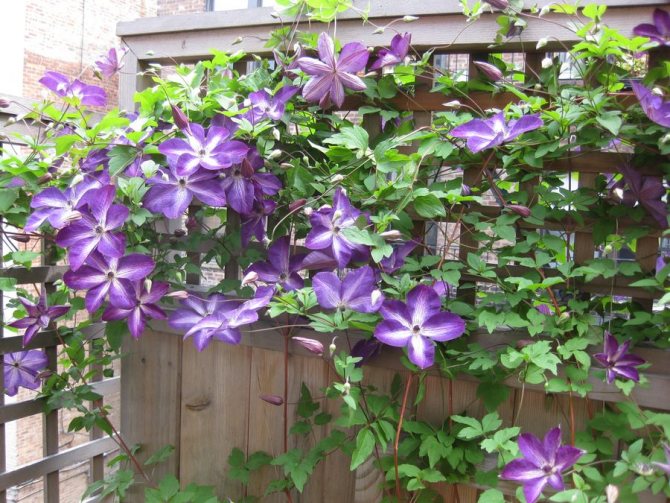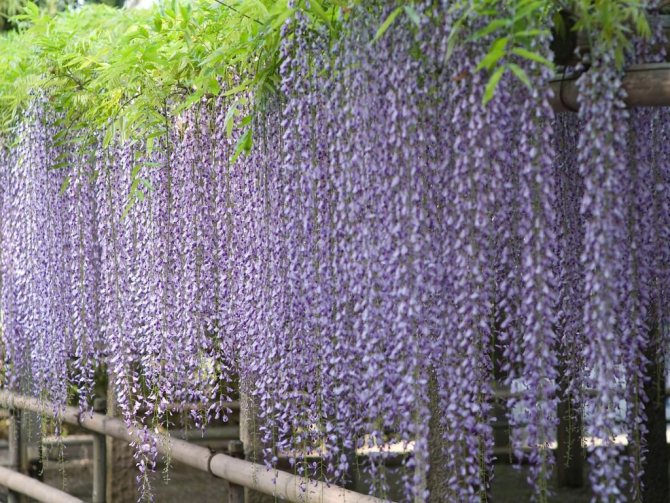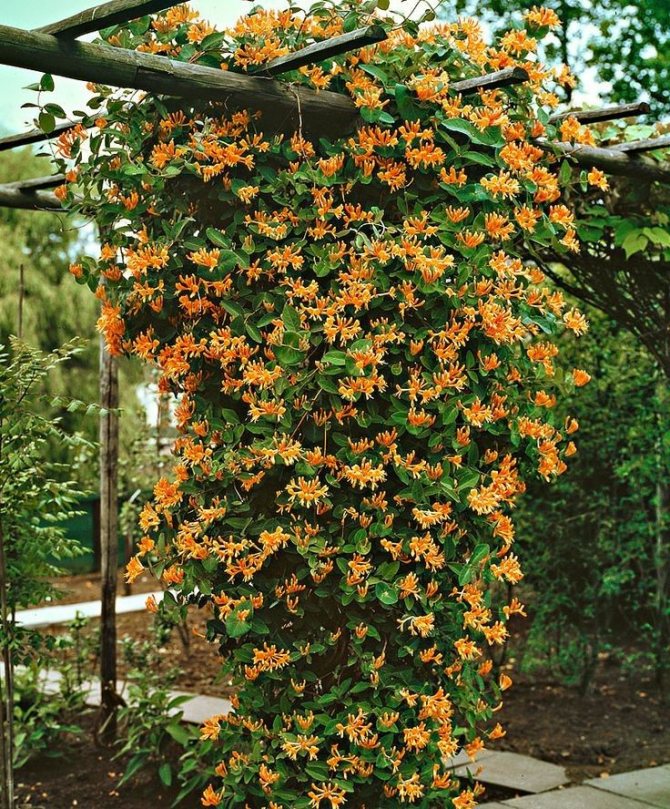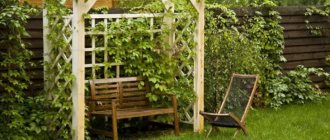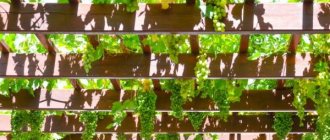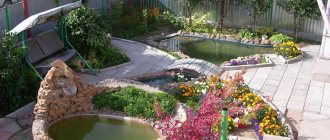The dream of every summer resident is a gazebo by the pond. With the latter, things are problematic. But you can always install a gazebo! The dream is already pleasing to the eye on your personal plot. In what style should you arrange it?
You can, of course, leave it in its original form - made of wood, or brick, or iron fittings. But! Agree - it's boring. At the dacha, everything blooms, turns green, pleasing the look. Let your gazebo not stand out from the riot of colors and aromas. An original and practical solution is to plant climbing plants to decorate the gazebo.
Abundant shade in sunny weather will create coolness and help escape from the heat. You will enjoy a long-awaited vacation. In windy weather, you can hide behind such a hedge inside the gazebo from the drafts. In cloudy weather, it is pleasant to take a blanket, a cup of delicious tea or a glass of homemade wine, sit in your favorite gazebo and listen to the rhythm of the rain, which has just begun to gain strength. Relatives and friends will not be able to refuse to taste your signature barbecue, discuss topics of interest or dance in nature!
Climbing plants for a gazebo are annual or perennial.
If you are ready to plant annually, to be creative, to change the design of the gazebo, then annuals are your option. If you don't have enough time, give preference to perennial climbing plants. Today we will tell you exactly about them. First, let's figure out what varieties this class is represented by.
By the ability to tolerate low temperatures:
- frost-resistant;
- requiring additional protection of the shoot base with sawdust, dry leaves or peat before the first frost.
In the fastening system, there are:
- suction cups, aerial roots (such plants with a death grip attach to any surface, even to a stone);
- antennae, hooks (most reliably attached to mesh supports);
- flexible lashes (independently cover the support with the trunk);
- without fixing devices (they need to be tied to a support).
Below are the names of the perennial climbing plants for your gazebo. Let's consider their advantages and disadvantages.
What climbing plants to plant near the gazebo, if you are a very lazy gardener, will not be a problem for you now. You can choose from three of the most unpretentious and common plants: common ivy, maiden grapes or common hops.
Criterias of choice
A huge number of different types of climbing perennial plants makes the gardener think about how to choose the best option for gardening a gazebo. Of course, the primary selection criterion is the decorativeness of the plant. It is also worth emphasizing that perennial plants must be winter-hardy. This will allow, with the arrival of spring, not to worry about the safety and restoration of plantings. The relative unpretentiousness of climbing plants is also important for gardeners who do not want to spend a lot of time and effort caring for them.
All climbing perennials can be roughly divided into evergreen, flowering and fruiting. Moreover, the fruits of some vines are not only edible, but also have an excellent taste and a complex of vitamins.
What plants are better to choose
The climbing plants listed above are suitable for a variety of purposes. And you need to be guided when choosing them. Should the plant be blooming or fragrant? Maybe there is no opportunity or desire to often look after him? Or is the site in the shade? Maybe you need to close the old fence? By answering these questions, you can choose the perfect plant.
926
Author of the publication
offline 2 months
Nika
59
Comments: 0Public: 167Registration: 25-06-2018
Evergreen climbing perennials
A gazebo, shrouded in greenery, can always become the highlight of the garden. She personifies the freshness and strength of nature. The absence of lush flowers will not allow the gazebo to "displace" the existing flowering flower beds from the general home design, only emphasizing their beauty.
Ivy
Among evergreen climbing plants, ivy is most often used to decorate gazebos and fences. Its advantage is its unpretentiousness and high frost resistance. The length of the plant can reach 30 m. Additional shoots and adventitious roots are massively formed on its main stems. They firmly cling to the existing supports, lifting the greenery up.
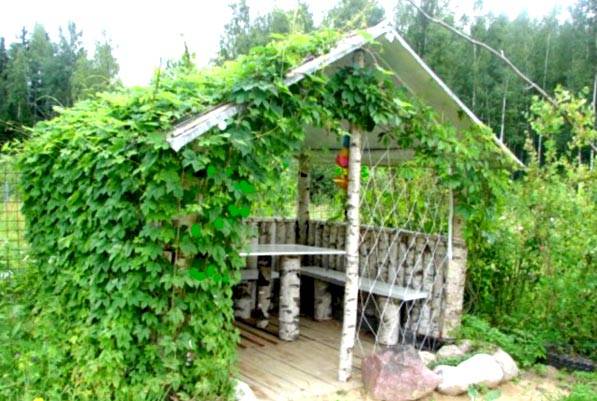
There are 16 different types of ivy, but common ivy is most often grown in Russia, since it has exceptional winter hardiness. In the central part of Russia, you can not prepare it for winter at all, without fear of freezing. In the northern regions, the plant must be removed from the support and covered with spruce branches for the winter. Common ivy can be grown in lowlands and rocky soils. The plant is unpretentious in care. The leaves of common ivy are carved, have a dense skin and a shiny glossy surface.
Important! All varieties of ivy are poisonous.
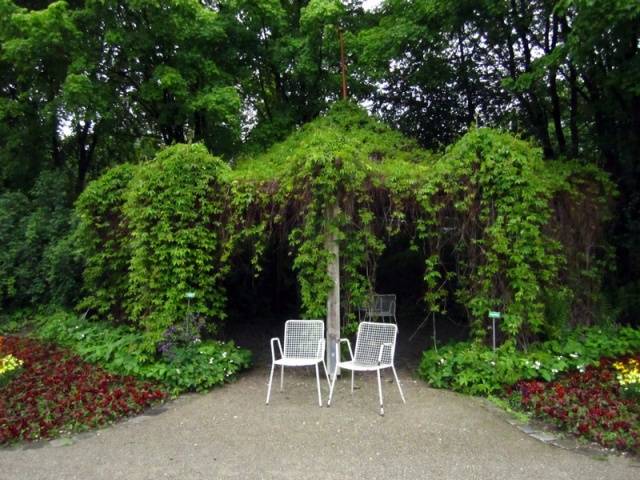

To decorate gazebos, ivy must be planted around the perimeter of the building. Within 2-3 years, climbing plants will cover the entire required area.
Maiden grapes
This curly perennial has high decorative qualities. Its leaves in the summer season are painted in the usual green color, but with the arrival of autumn, their color becomes bright red, which allows you to bring colors to an already extinct garden. The length of the shoots of maiden grapes reaches 20 m. The plant is able to crawl up the support or gracefully hang down from top to bottom. Curly perennial with its large leaves tightly covers the surface of the gazebo, protecting the interior from drafts and summer heat.
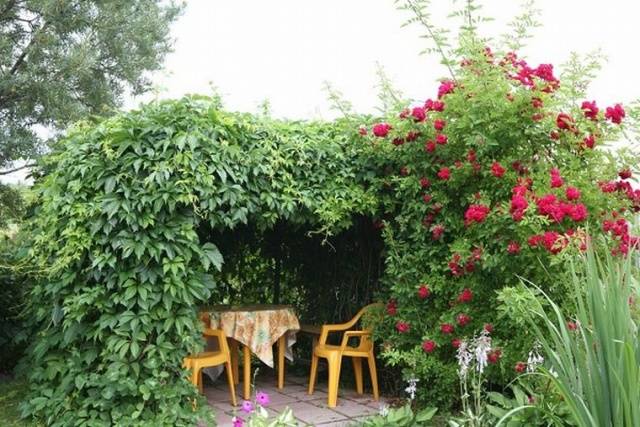

Maiden grapes are especially popular with Russian gardeners. This is primarily due to its high resistance to freezing. In addition, the climbing perennial is very unpretentious to growing conditions. A small piece of land is enough for him to build up abundant green mass. During the growing period, the plant does not require regular feeding, it is enough to apply fertilizer to the hole when planting it.
With the help of this perennial it is easy and simple to decorate the gazebo with your own hands. To do this, you need to plant plants around the perimeter of the building. A fast-growing perennial, its vines grow by an average of 3 meters per year, which means that already 2 years after planting, you can count on the entire surface of the gazebo to be tightly entwined with beautiful foliage.
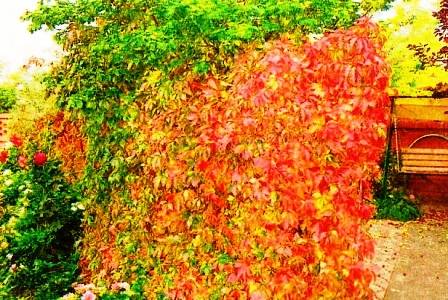

Important! Maiden grapes bloom every season with small flowers, which eventually turn into poisonous berries.
When such fruits are eaten, the mucous tissues of a person get burned.
Hop
This perennial climbing plant is known to many gardeners. Its feature is the rapid growth of shoots, the height of which reaches 7 m. This height is quite enough to cover the arbor walls and roof.
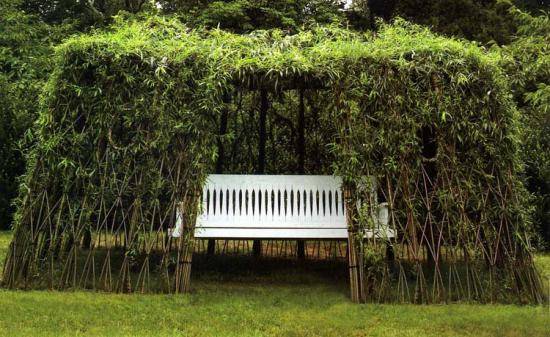

Important! Hops are not a very creeping perennial plant, which is why it needs to be helped to climb up, wrapping young shoots around the supports.
Common hop has good winter hardiness, however, its disadvantage is demanding care and susceptibility to various diseases.So, once every 2 months, climbing perennial plants need to be fed with mineral or organic fertilizers. The enemy of hops is powdery mildew, which appears as a gray or white bloom on the inner surface of the leaf.
This curly perennial blooms every year. Its female inflorescences are small lumps of light green color. Male inflorescences are represented by unsightly white flowers.
Important! Hop cones are used in medicine and brewing.
These perennial climbing plants are great for decorating gazebos with your own hands. It is not at all difficult to plant them around the perimeter of the building, 1 seedling for every 80 cm of the perimeter. They are unpretentious to care for and do not require shelter for the winter.
Decorating a fence from a chain-link mesh
Many resort to inexpensive, not very attractive fencing of their site from a chain-link mesh. This method has the advantage - the cells are able to hold any climbing plant. Decorating the net with weaving vines is gaining more and more popularity.
To completely hide the fence, you should choose plants with large leaves or densely growing. Ivy or hops are ideal. They grow quickly, by the middle of summer the nondescript fence will be completely covered with a thick carpet of greenery.
Clematis and flowering annuals are well suited for this purpose. Large bright flowers will decorate any fence.
But kampsis or wood-nose pliers will not work for the netting netting, since strong heavy shoots can knock down such a fence.
With the help of climbing plants, you can refine any nondescript fence, give it sophistication and individuality. From the many options, it is easy to choose unpretentious and fast-growing ones, which, even in the hands of an inexperienced gardener, will bloom profusely and delight with their splendor.
Blooming perennials
Beautiful curly vines with lush flowers always attract the attention of passers-by. Climbing plants can be used to create the flower walls of the gazebo. A structure entwined with such perennials will become a decoration of a green garden.
Wisteria
This climbing plant is a leafy vine. Its length can reach 20 m. Inflorescences up to 30 cm long are formed on the shoots of a perennial plant. A feature of wisteria is the duration of flowering: inflorescences are formed in early spring, simultaneously with the appearance of leaves and continue their flowering until autumn. Along the entire length of the inflorescences, bright small flowers bloom in large quantities at the same time. Their color, depending on the variety, can be varied: white, pink, blue, lilac. You can see all the fantastic beauty of these stunning perennial plants in the photo.
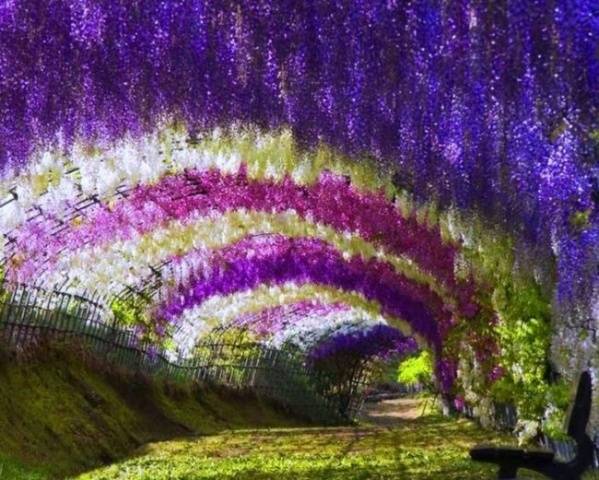

Wisteria is considered a rather whimsical climbing plant that requires moderate watering, regular feeding and a lot of light. Vine hardiness is also not too high. Without shelter, wisteria can only withstand short-term frosts at -20C. In the harsh climatic conditions of Russia, wisteria must be covered with burlap and coniferous spruce branches for the winter.
Pruning is of particular importance when growing this climbing perennial. Each year in the spring, the vines are pruned, leaving only 30 cm of last year's shoots. This will allow the perennial to bloom profusely every year on old and new shoots. In autumn, after the end of flowering, wisteria is also cut into 2-3 buds for a better bookmark of flower buds.
Important! The value of wisteria lies in its abundant and lush flowering.
Clematis
Clematis are known to many gardeners. They can decorate the surface of any gazebo with lush flowers. The genus of clematis includes many varieties and hybrids. They differ in size, terry, flower color, flowering period.Each type of perennial plant needs certain growing conditions. In particular, this applies to pruning. So, clematis, blooming on the shoots of last year, are slightly pruned once every few years. Plants that form flowers only on young shoots are pruned every season, leaving petioles of 20-30 cm.If a perennial climbing plant forms flowers on last year's and new shoots, then it must be pruned every time in the fall, leaving 1-1.5 m shoots.
Growing perennial clematis requires a lot of care and attention. The developed root system of a climbing plant requires a lot of moisture and a sufficient amount of fertilizer. After cutting the plants for the winter, clematis shoots must be covered with burlap and spruce branches to prevent freezing.
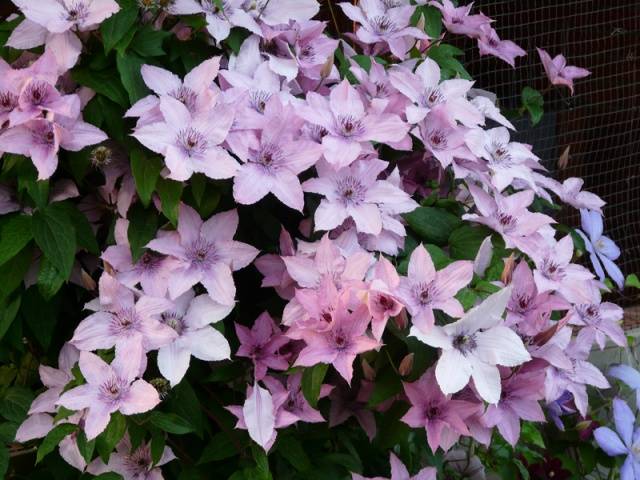

Important! Perennial curly clematis can withstand frosts without shelter up to -60C.
Climbing roses
You can also decorate gazebos in the garden with climbing roses. These luxurious perennial plants give a greater growth of shoots every year, which allows you to quickly create "living" walls of the structure. Perennials are distinguished by their whimsicality, but their charm falls in love with many gardeners, which is why you can often see arches and gazebos entwined with this plant in gardens.
Important! Climbing roses do not cling to the support on their own, so they must be tied up.
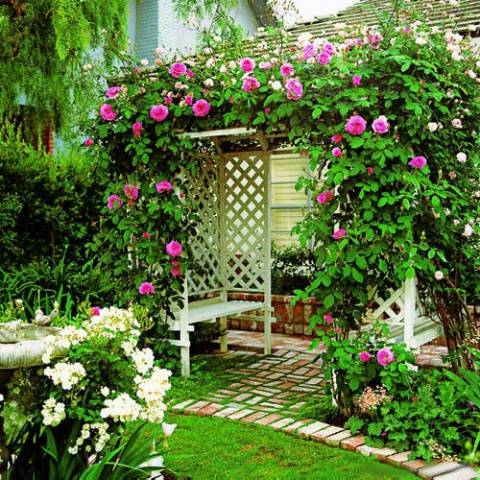

Climbing perennial roses are demanding on the composition of the soil. When planting them, several kilograms of manure should be added to the soil and, as the plants grow, additional nitrogen fertilizers should be added to the soil.
The cold resistance of perennial climbing roses is relatively low, so every autumn the shoots must be removed from the supports and covered to prevent freezing. Long strings of roses need to be pruned in spring and autumn. Such care of plants is quite troublesome, however, the beauty of the gazebos decorated with climbing roses is worth it.
You can learn more about how to grow beautiful perennial climbing roses by watching the video:
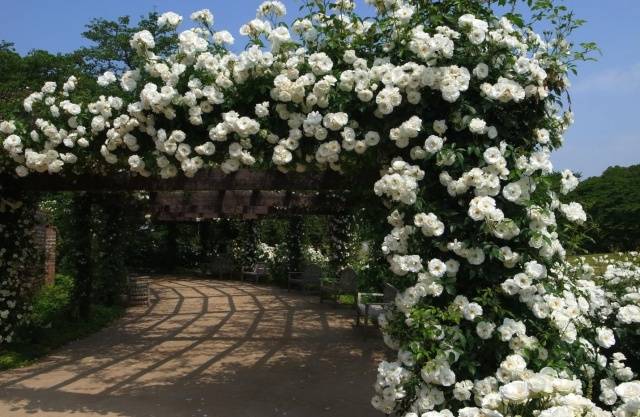

"Blooming" gazebos always look beautiful and romantic, however, it takes a lot of time and effort to create them. That is why this decoration option is more suitable for caring and diligent gardeners.
Treelike vines requiring shelter from frost
Treelike vines requiring shelter from frost include the above clematis... The plant belongs to the buttercup family and is revered by most flower growers and gardeners. The color of the flowering is striking in its variety, and the flower itself can be in different variations of forms. The plant is grown by seeds.
In appearance, the liana is grassy with a shoot height of about 4 m. The stem is tree-like. The plant can be of several types:
- Clematis with a small flower, about 3 cm in diameter;
- Clematis with a large flower, about 12 cm in diameter.
The flowering of the plant lasts about 90 days. On one bush, about half a thousand bright flowers can be located at the same time, having such shades as:
- Snow white;
- Pale purple;
- Dark violet;
- Red;
- Cherry;


Curly rose
Crimson;- Pale pink;
- Aquamarine;
- Yellow etc.
Another representative of the tree liana, with no less beautiful flowering, is curly rose... If the choice fell on vertical gardening of the gazebo, then such a plant would be the best solution. The shoot of such a rose can curl up to 5 m in length. Stems are green, covered with numerous twisted thorns. Flowering occurs in the form of small flowers about 2 cm in diameter. They are:
- Terry surface;
- Partially terry;
- Ordinary.
The flower is usually an inflorescence with little or no aroma. Vigorous flowering lasts for 3 weeks, at the very beginning of summer. Easily tolerates winter frosts under suitable shelter.
Green arbors "tasteful"
Among frost-resistant climbing perennial plants, there are those that will not only bring aesthetic pleasure and serve as the walls of the gazebo, but will also delight you with a harvest of delicious berries. The vineyard and actinidia can be classified as such climbing perennial plants for the gazebo.
Vineyard
Making a canopy or gazebo from grapes with your own hands is not at all difficult. To do this, you need to build a reliable frame and plant a vine at its foot. For decorating gazebos, the Amursky black-fruited variety or the Russian Concord green grapes are perfect. The grape variety "Brant" is highly resistant to frost and can also be used to decorate gazebos.
A vivid example of how to design a structure using this plant can be seen in the video:
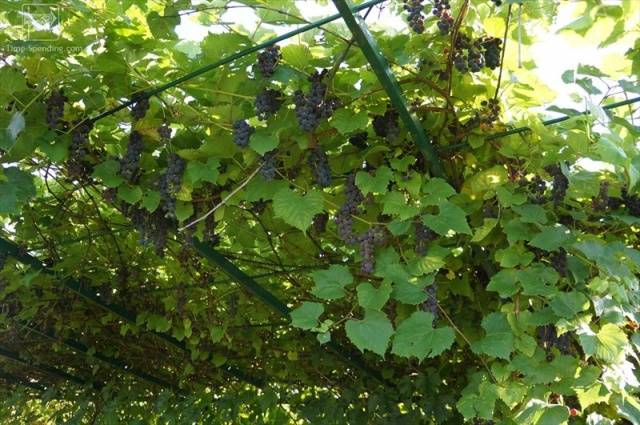

A grape gazebo will delight you with a good harvest only with proper care for perennial plants, which includes regular watering and feeding. The rules for pruning and covering the vine depend on the cultivated variety.
Actinidia
These unique perennials are climbing vines, whose fruits are edible, resembling kiwi in appearance and taste. At the same time, the plants are winter-hardy, which means that they can be successfully grown in the domestic open spaces. Planted around the perimeter of the gazebo, actinidia very quickly cover the free space, and in a few years the length of perennial plants will reach 30 m.
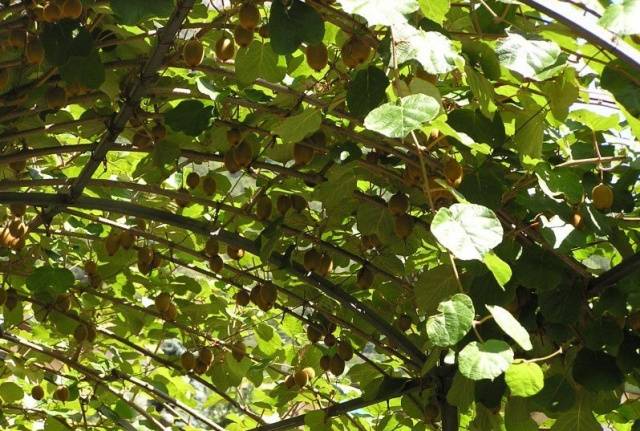

Actinidia are dioecious perennial plants. For fruiting in the immediate vicinity, it is necessary to plant a female and male vine at once. It is worth noting that actinidia "Adam" is an excellent variety of the male flowering type. Its leaves are variegated: a green leaf blade with a bright pink tip. This feature adds even more decorative effect to the perennial climbing plant.
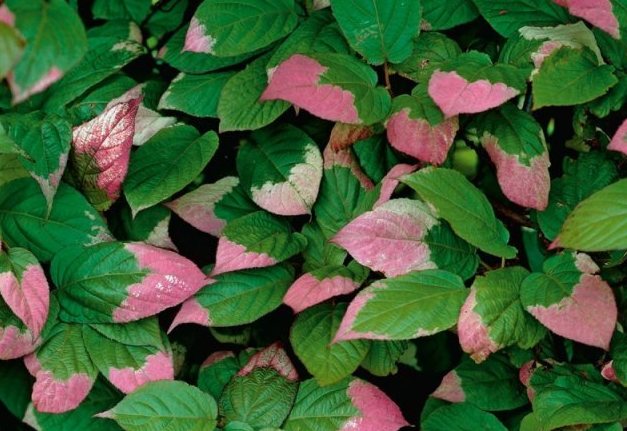

Treelike vines frost-resistant
Frost-resistant vines for a gazebo include maiden grapes. One of the tallest plants, the growth of shoots reaches almost 30 m in height. The foliage has a decorative appearance that ennobles the gazebo from early spring to late autumn.
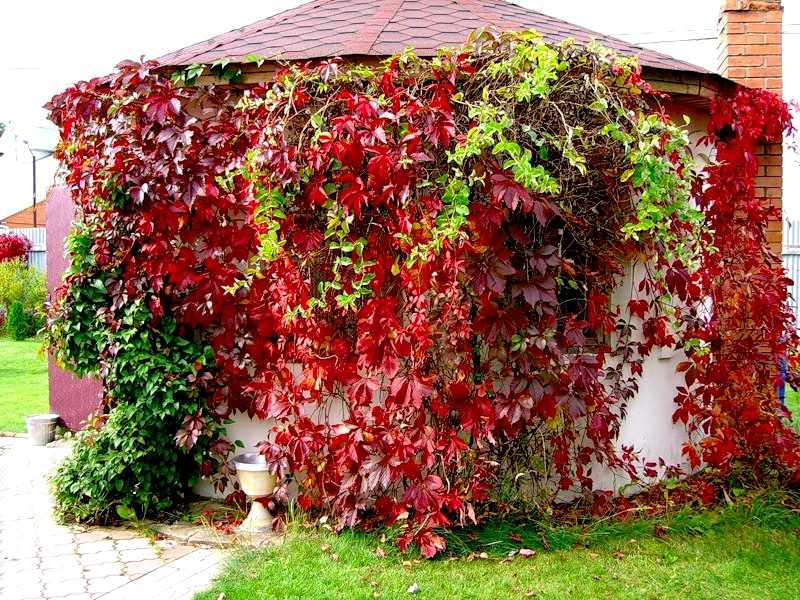

Maiden grapes
Due to the height of the stems, it needs reliable support, therefore the gazebo structure is perfect.
Liana can be propagated both by seeds and by cuttings.
It is very often used as a decor for the wall of a house, but the weaving effect on the gazebo supports looks no less attractive.
Actinidia can also be attributed to common tree lianas.. The plant is a chameleon, it can change several colors over the entire summer period. Reaches a fairly tall height, about 13 m. In spring, it is covered with bright foliage in green tones. With the onset of warmer days, landscaping takes on a white tint, which is gradually replaced by a pink color.
Actinidia
Besides the decorative look, liana is famous for its fortified berries, which practically do not differ in taste from gooseberries.
The special qualities are:
- Unpretentious care;
- Frost resistance, even without shelter;
- Lack of requirements for choosing a landing site on the site.
Herbaceous vines
Hop
The best representative of herbaceous climbing vines will be hop. Its peculiarity is the complete dying off of shoots with the onset of a significant cold snap. But in early spring, the shoot is revived. It has shoots underground, which allows it to cover large areas for growth.
The foliage looks very decorative in early summer, and then opens the eye with the appearance of many cones.
Hops are famous for their beneficial properties and are used in medicine. It is also actively used for the manufacture of alcoholic beverages.
Wisteria or wisteria
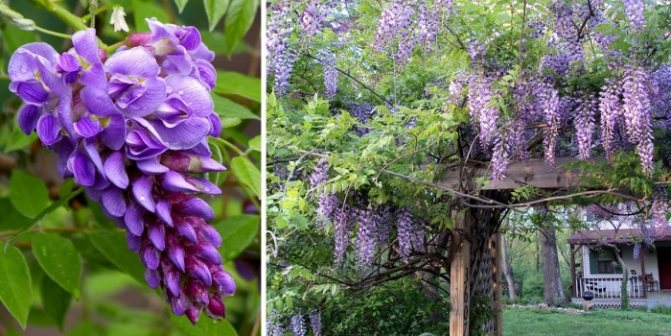

Today, breeders have developed such varieties of subtropical wisteria that they are able to tolerate even frosts down to -40 ° C. In particular, this is the Blue Moon wisteria macrostachia variety.This variety can now be planted in the middle lane. This climbing plant will perfectly decorate the columns in the gazebos with its delicate bluish-purple flowers.
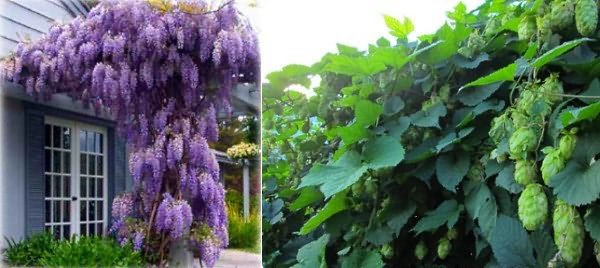

After wisteria is planted, it should be watered constantly until the end of summer. This is necessary for the plant to thrive in moist soil. However, it should not be very wet. When it comes to mid-September, watering should be reduced beforehand. If you want to have a spectacular flowering, then during the growing season, the soil should be fed once for seven days. Both organic and mineral fertilizers should be used as fertilizer. When decorating a veranda and a gazebo, the plant should be regularly tied up and guided.



